
~~~~~~~~~~~~~~~~~~~~~~~~~~~~~~~~~~~~~~~~~~~
Live Earth Farm (Com)Post
16th Harvest Week, Season 12
July 16th - 22nd, 2007
~~~~~~~~~~~~~~~~~~~~~~~~~~~~~~~~~~~~~~~~~~~
(click here for a pdf of the paper
version of this newsletter)
In this issue
--Basil bounty - Free
Basil!!
--Greetings from Farmer Tom
--Notes from the Field
--Mataganza Garden Sanctuary Internship Program
--Pictures around the farm
--What's in the box this week
--Notes from Debbie's Kitchen
--Calendar
--Contact Information
" As farmers, we are emotionally involved, personally
engaged and spiritually invested ... surviving as both art and business
... we perform despite limited economic incentives because we offer
gifts to the world. "
~ David Mas Masumoto, from "Four Seasons in Five Senses"
Basil Bounty - FREE BASIL!!
~~~~~~~~~~~~~~~~~~~~~~~~~~~~~~~~~~~~~~~~~~~~~~~~
At each pick-up site this week there will be a box with loose basil in it, free for the taking. Please take as much as you want! We have a bumper crop of basil right now, and in order to keep the plants healthy and prevent them from bolting, they need to be picked. But rather than throw it on the ground to compost between the rows, we are going to harvest and collect it, and offer it to you. The basil will not be bunched, it will simply be loose, in one of the plastic bag liners, inside a waxed box at your pick-up site. We will leave the box open, but the bag may be closed over the top of the basil to help keep it fresh. Take as much as you like, then close the bag up again to keep it fresh for the next member. Debbie will give you extra recipes and ideas for using it.
Greetings from Farmer Tom
~~~~~~~~~~~~~~~~~~~~~~~~~~~~~~~~~~~~~~~~~~~~~~~~
Eating locally and seasonally by joining our CSA is, in my eyes, a fairly radical
if not revolutionary step – one that affects both eating habits and lifestyle.
When you first signed up to join, you took a bold step, choosing to participate
in the seasonal journey of this particular farm. If it’s your first time
as a CSA member, it can be difficult to anticipate what you where getting yourself
into. By now, for instance, summer is in full swing, and you’re probably
wondering when you'll be getting tomatoes, cucumbers and peppers; and hoping
that the chard, kale, arugula or never ending supply of beets and carrots will
slow down.
Getting a box of vegetables every week, all from the same farm, can be challenging.
Diversity doesn't appear overnight, but happens gradually over the course of
an entire season. Sometimes this requires learning to cook with more unusual
vegetables, such as mizuna, Chinese cabbage or fava beans; other times it means
coming up with creative culinary ways to prepare the same vegetable a couple
weeks in a row. If you lived here where the farm is – the central Coast,
where cauliflower, broccoli, leafy greens and lettuces are year ‘round
staples – you’d understand that it’s our cool foggy summer
days that delay the ripening of the popular heat-loving crops. I know that by
the time our cucumbers and tomatoes are ripe and in your shares, you’ve
already seen them piled high in stores and at farmers markets for weeks. But
the green beans and cherry tomatoes now appearing in your shares are a sign that
the summer veggies are imminent.
Each farm is different, defined by its climate, soil conditions, size, market,
and most importantly, the people who live on and work the land. Still, the feedback
and stories we get from you are also important. Many members have expressed to
us over the years that getting a share is like getting a surprise box, or like ‘Christmas
every week.’ On the other hand, last week a member commented about the "holey" arugula,
which, with its many little holes, resembled Swiss cheese. Unhappy with its appearance,
he threw it out. True, if you went shopping in a store this ‘holey’ arugula
would probably never make it into your shopping basket. But in this case, appearance
is deceiving, since the taste is unaffected. And unlike the blemish-free store
product, it tells a story... in this case, it is story about the life cycle of
a common little beetle, the flea beetle, which loves to munch on mustard greens,
and happened to peak at the same time our arugula started sprouting. Normally
in this situation we like to cover the crop with a light, gauze-like blanket
commonly known as ‘row cover’, to reduce the flea beetle damage.
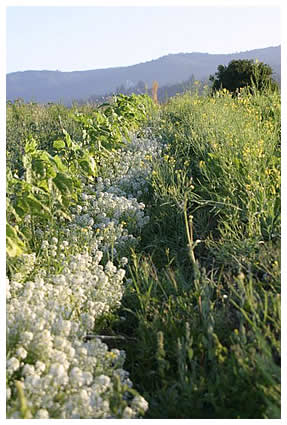 This time, however, we had to leave the blankets off due to the higher temperatures
from a couple of short heat waves we experienced in the last three weeks. The
veggies you get from us will always have a story to tell, about the complexity,
the cycles and character of this farm. As a member, you will not necessarily
be eating what is easiest and most convenient for you. Sometimes you are asked
to be more flexible, to be open to trying new things and discovering the flavors,
textures and characters of food that can be grown at the time and place where
you are now. - Tom
This time, however, we had to leave the blankets off due to the higher temperatures
from a couple of short heat waves we experienced in the last three weeks. The
veggies you get from us will always have a story to tell, about the complexity,
the cycles and character of this farm. As a member, you will not necessarily
be eating what is easiest and most convenient for you. Sometimes you are asked
to be more flexible, to be open to trying new things and discovering the flavors,
textures and characters of food that can be grown at the time and place where
you are now. - Tom
<back to top>
(at left, sweet alyssum and sunflowers are planted between crop rows
to attract beneficial insects for natural pest control)
Notes from the Field
~~~~~~~~~~~~~~~~~~~~~~~~~~~~~~~~~~~~~~~~~~~~~~~~
The seasonal diversity is becoming more apparent with the content of
this week’s
share. The dry-farmed tomatoes in the Family Share should be in all the shares
by next week. Cherry tomatoes will be more abundant in both shares for the next
4 to 5 weeks. Broccoli is back for a couple of weeks, and the arugula – don't
be turned off by the holes; they’re just the pock-marks of our little jumpy
friends the flea beetles – is perfectly tasty tossed in salads, or sautéed.
Soon to come are peppers and eggplant. 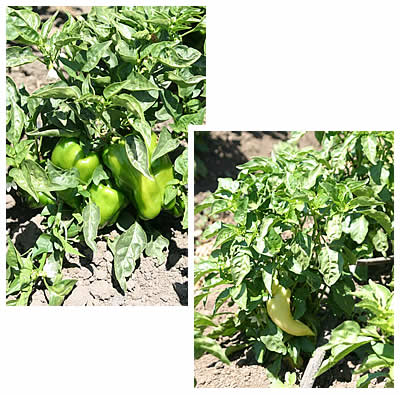 Also,
I would say in the next 2-3 weeks we should be getting the delicious Armenian
cukes, also known as snake cucumbers. Our biggest challenge right now is aphids
which are quite abundant right now, so if you do find them it's because they
got past our scanning eyes during harvest. A strong stream of water or a quick
boil will get rid of most of them (Debbie has a few suggestions too).
Also,
I would say in the next 2-3 weeks we should be getting the delicious Armenian
cukes, also known as snake cucumbers. Our biggest challenge right now is aphids
which are quite abundant right now, so if you do find them it's because they
got past our scanning eyes during harvest. A strong stream of water or a quick
boil will get rid of most of them (Debbie has a few suggestions too).
<back to top>
(at left, upcoming peppers: green bell and yellow Hungarian wax)
Mataganza Garden Sanctuary Internship Program
~~~~~~~~~~~~~~~~~~~~~~~~~~~~~~~~~~~~~~~~~~~~~~~~
Hi everyone, my name is Brian Barth; I live here on Live Earth Farm, and teach
permaculture in the Mataganza Garden Sanctuary. (If you missed seeing the Garden
when you were here for the Solstice, be sure to stop by during the Fall Harvest
Festival. It is a beautiful spot.)
Thank you to those that made our Spring internship program a great success. We
got almost the entire garden mulched, did lots of planting, some propagation
work, worked on hand-made plant labels, and made a medicinal tincture from herbs
in the garden.
Starting again in August, we'll host a six week program for people wanting to
get hands-on experience in ecological gardening techniques, appropriate horticulture,
natural building, permaculture design, and other topics. Our special focus for
this session will be on harvesting and processing plants from the garden for
medicine, food, natural dyes, and teas, etc. It will happen on six Fridays, from
10am to 6pm each day. The dates are August 10, 17, 24, 31 and September 7 and
14. There will be a $150 fee collected as a contribution towards the materials
needed for our work in the garden. Each day will include hands-on instruction
relevant to the projects at hand, to be determined by the needs of the garden,
and will serve to tie theory and practice together.
For more info or to sign up, for please contact me –
by phone, at 831-566-3336 or
by email at edenfruits2002@yahoo.com
Hope your enjoying the bounty of Summer,
Brian
Pictures around the farm
~~~~~~~~~~~~~~~~~~~~~~~~~~~~~~~~~~~~~~~~~~~~~~~~
Sunrise as opposed to fog in the morning means a hot day is imminent.
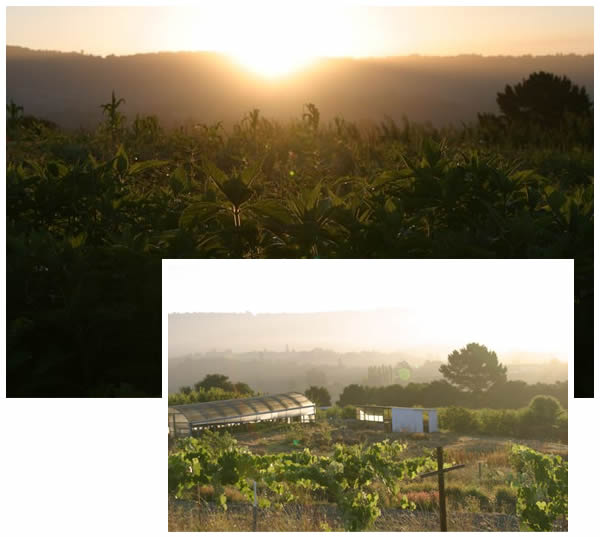
The Concord grapes are coming along nicely!
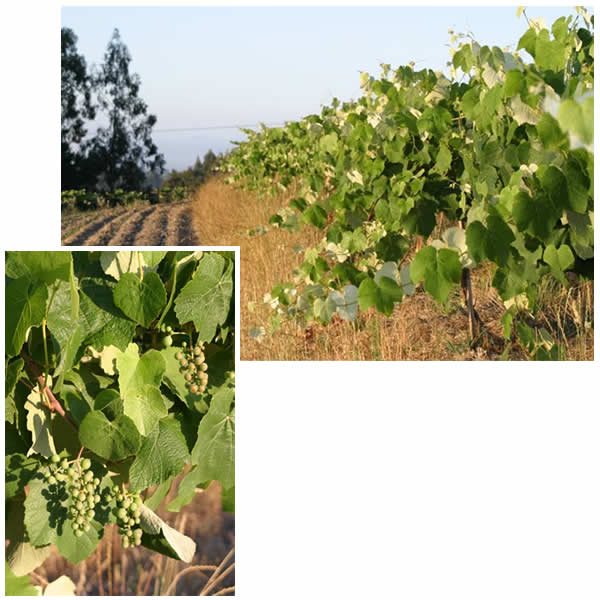
A spread of our early summer bounty!
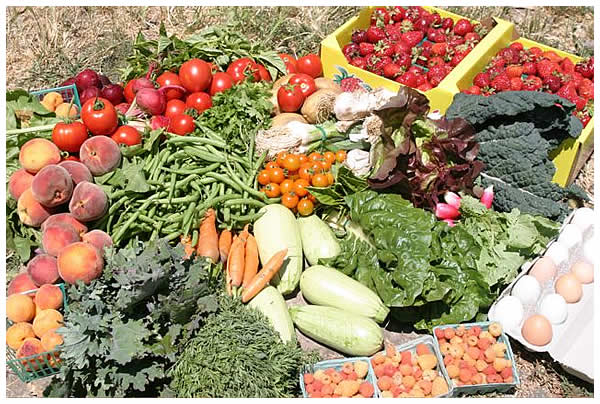
The diversity in the plantscape on the farm includes more than the crops
we grow: yellow mullein from the Mataganza Garden Sanctuary, weeds
and volunteers (in this case, a stalk of corn!) growing amongst the row
crops... and a beautiful rose hip from the house garden.
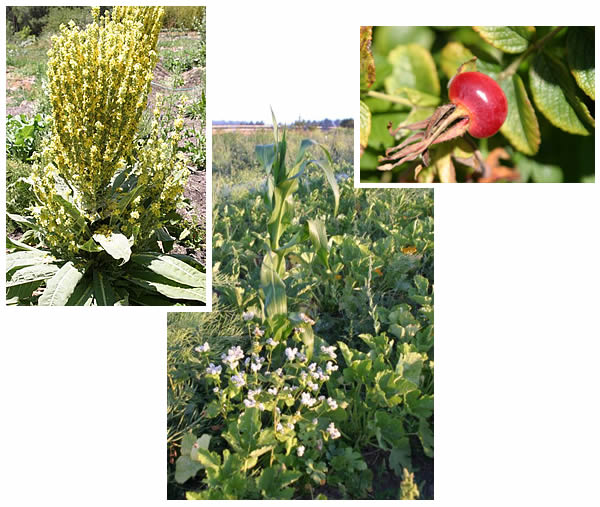
<back to top>
What's in the box this week
~~~~~~~~~~~~~~~~~~~~~~~~~~~~~~~~~~~~~~~~~~~~~~~~
(Content differences between Family and Small
Shares are underlined and italicized; items with a “+” in
Family Shares are more in quantity than in Small; anticipated quantities are
in parentheses. Sometimes the content of your share will differ from what's on
this list, but we do our best to give you an accurate projection. It's Mother
Nature that throws us the occasional curve ball!)
Family Share:
Holey arugula
Basil
Beets (golden or chiogga)
Broccoli (Lakeside or LEF) +
Carrots
Green beans
Lettuce +
Radishes
Spinach +
Summer squash +
Sungold cherry tomatoes
Dry-farmed tomatoes
Strawberries (1 basket)
Small Share:
Basil
Broccoli (Lakeside or LEF)
Carrots
Green beans
Lettuce
Parsley
Potatoes
Radishes
Spinach
Summer squash
Sungold cherry tomatoes
Strawberries (1 basket)
Extra Fruit Option:
Plums, blackberries, strawberries, and
(Weds) apricots, or
(Thurs) raspberries
"Strawberry Bounty" Option:
4 baskets of strawberries
<back to top>
Notes from Debbie's Kitchen
~~~~~~~~~~~~~~~~~~~~~~~~~~~~~~~~~~~~~~~~~~~~~~~~
Click
here to go to my extensive
recipe database, spanning 10 years of CSA recipes and alphabetized
by key ingredient. Includes photos of most farm veggies; helpful for
ID-ing things in your box! Also, FYI, as a rule, I put my own comments
within recipes that are not my own inside square brackets [like this]
to distinguish them from the voice of the recipe-writer. - Debbie
What I’d do with this week’s box
There’s a wonderful recipe for beets with
pasta, sour cream garlic and parsley that I haven’t made
in a while. That was good. Alternatively, since we’re getting the golden
and chiogga beets this week (and if you’re like me, you probably still
have other beets in your crisper from prior weeks), I’d make a colorful beet salad – take
advantage of the different colors! In a nutshell, you simply cook the beets,
peel, dice, and dress them separately, then serve them in little piles on a bed
of that holey arugula.
No need to dress the arugula; the dressing from the beets will dribble down over
it and take care of that. Another good use for parsley is to include some
of it in your pesto.
The value of doing this is it helps preserve the bright green color. Green
beans, cherry tomatoes and potatoes are
great in various combinations; sometimes I’ll make a potato-green
bean salad with cherry tomatoes; ooohhh, I almost forgot! A really yummy
way to prepare green
beans is like roasted oven garlic fries, sometimes called ‘Ugly
Green Beans’ because they’re all brown and blistered, but boy
are they good! Children love them. Spinach again? Oh, everybody has there
favorite way to use it so I hardly have to give you ideas, but I am running out
of spinach-potato
gnocchi so I’ll probably make some more. Member Laurel Pavesi made
a great suggestion: mince up fresh herbs and add to your gnocchi dough. I’m
going to have to try that! Summer squash? Grill it (baste w/olive oil,
salt, pepper), chop it up, and toss it into some cooked penne or similar pasta
along with some halved cherry tomatoes and... pesto,
of course! Good hot, room temp, or cold. Carrots I often just dip in peanut
butter and eat for lunch! Radishes...
yes you can cook them, or slice them into salads, or put them into a stir-fry,
but my favorite way to eat them is still in a radish
sandwich – thinly
sliced and piled onto buttered sweet French baguette. Be sure to click on the
link to this recipe in order to get the sweet story behind it. Ever since I learned
this, it’s been my favorite way to eat ‘em.
What to do with all that basil??
In addition to making fresh pesto, did you know you can freeze pesto, freeze
the basil leaves, or even dry them? I’ll talk about each in succession.
First: refrigerating pesto. Although it’s great to use it the
day you make it, it actually lasts a few weeks in the fridge when stored properly.
When I make a batch of pesto, I put it in a glass jar, then carefully press
a piece of plastic wrap down against the surface of the pesto inside the jar
before closing the lid. This helps minimize the amount of surface area exposed
to the air (which causes oxidation). It’ll keep this way two weeks or
more (I think – I’ve never not used it up before then, but two
weeks out, still good). Some people like to pour a quarter inch of olive oil
over the top to protect it, which is also fine. Just keep in mind that the
oil coagulates and gets cloudy when refrigerated (but comes back to liquid
form at room temperature). If you open the jar to take some out, be sure to
smooth out the surface of the pesto again and re-cover with plastic or oil.
Freezing Pesto. I’ve heard that when freezing pesto you should
leave out the cheese (adding it later when you’ve thawed it for use),
but I don’t think that is a problem. Granted frozen pesto may not be
the same as fresh, but if you make it now, you can enjoy the taste of summer
all through the winter! (Well, at least until your pesto runs out.)
A fellow on the internet had a great suggestion: put the pesto you want to freeze
into a ziploc bag, cut off one corner (about ½”), then squeeze the
pesto into ice cube trays (don’t overfill them, or you’ll have a
mess). To prevent oxidation while freezing, lay a sheet of plastic wrap over
the top of each tray and gently press down against the surface of the pesto.
Stick trays in the freezer until frozen, then remove plastic wrap (if it sticks,
a cloth dipped in warm water and wiped across the surface should briefly thaw
the very surface of the pesto, freeing the wrap), decant the cubes into another
ziploc bag (or if you have a vacuum sealer, even better), suck out as much air
as you can then close the bag and stick back in the freezer. To use, you can
either just toss a few cubes into hot food and stir until it melts, or put some
in a dish on your counter (quicker) or in your fridge (slower) until thawed,
then use normally. I would avoid quick-thawing in the microwave, because it’s
too easy to get hot spots and ‘cook’ the pesto.
Freezing fresh basil. Similar to the above technique, if you have lots
of basil you’d like to freeze and save for later, just chop up the leaves,
put them into ice cube trays, cover with water (try to push them down so the
water covers them), freeze, decant cubes into ziploc bags and store in your
freezer. When you go to cook with it, just toss the cubes into whatever you’re
cooking. The amount of water is negligible and will not affect your sauce or
dish.
Drying fresh basil. This I’ve done before, and it works just fine.
People will ask, ‘why dry it when you can use it fresh?’ Listen,
if I could use it all up when it was fresh, I would, but since I use dry basil
when cooking in the ‘off season’ I’d just as soon use the
basil I dried myself; I know where it came from and how recently it’d
been dried.
To dry it, simply pick the leaves off the stems, discard stems, and lay leaves
out on some flat surface (do not overlap them; spread them out so air can circulate) – a
plate, a tray, a wooden cutting board, a wire rack on a pan; or be creative and
stretch some cheesecloth out and tack it to, say, the back side of an old wooden
picture frame or something (i.e. a wooden rectangle. Do take the picture and
glass out first!). Place basil somewhere out of direct sunlight. Check it every
day, and when the leaves are thoroughly dry, you can either pack them whole into
an old spice jar, or crumble them into a bowl, then with a funnel, fill your
spice jar. Store the jar out of the light (you should do this with all your herbs
and spices!) and use like you would any dried herb.
Fortunately, prescient member Lori Wilkinson Rella sent me this wonderful
recipe for basil also, so here’s a fun way to use the basil fresh as
well. Lori says this is her favorite way to use a bunch:
Basil Shrimp
(originally from barbequerecipe.com; written here how Lori prepares it)
3 lbs. shrimp, peeled and de-veined
3 tbsp. country-style prepared mustard [I don’t know what ‘country-style’ is,
but I imagine most prepared mustards would do]
¼ C butter, melted
3 cloves garlic, minced
2 ½ tbsp. olive oil
1 bunch fresh basil, stems removed
juice of 1 ½ lemons
salt
ground white pepper
Add olive oil to melted butter, then add everything but the shrimp. Mix all together.
Add shrimp and toss to coat. Cover and refrigerate for 1 hour.
They recommend skewering the shrimp, then grilling over high heat for about 2
minutes per side. We've also used it as a pasta sauce: Boil some water for pasta,
and while the pasta is cooking, sauté the shrimp in the marinade until
the shrimp are cooked. Then toss the shrimp with the pasta and you're done. It's
delicious either way!
Removing aphids from broccoli
Granted we’re all happier when they aren’t present, but sometimes
the little buggers are there, and if they are, there are ways to get rid of
them other than throwing out the veggies they’re in! This is not an
excuse for giving you aphid-y broccoli; we will always do our best to weed
out the buggy ones, but sometimes they slip by the eyes of the harvesters and
into our shares anyway.
Broccoli is the toughest veggie to get ‘em out of, because they’ll
hide up in the florettes. I have a habit of inspecting my broccoli before cooking,
so I know if I need to do any ‘aphid control’. If they’re present,
they tend to appear most often inside the topmost florette, the one on the lead
or main shaft, as that’s the one that’s been around longest.
If I see I have some aphids, here’s what I do. The idea is to immerse the
head upside down in a pot of boiling salted water for a minute or two, so that
the aphids dislodge and float to the surface. Use a pair of tongs and be sure
your hand is in a protective mitt so you don’t get burned by the steam
as you hold it in there. After a minute or two, turn off the heat and, keeping
the broccoli immersed, carefully carry the pot and broccoli over to and set down
in your sink. Run the hot tap into the pot, still holding the broccoli under,
until the water overflows and the aphids floating on top pour over the sides.
Shake the broccoli around a bit to see if there are any more still to come out,
and overflow/rinse to your satisfaction. Then cut up your broccoli and use as
you would normally. It’s already partially cooked at this point, so remember
to take this into consideration in your recipe.
If the aphids are in broccolini instead of broccoli, I’ll hold them under
the boiling water with a potato masher or something, anything to keep them below
the surface until they give up the ghost and float to the top. Then do the sink/rinse
procedure as described above.
Apricot-Plum Pie redux
Well folks I followed through on last week’s idea – to modify
that apricot
pie recipe and make it half apricots, half plums (only I did
about two-thirds apricots, one-third plums) – and it was unbelievably good!!
Still is, as a matter of fact (we’ve got half the pie left in the fridge;
we love fruit pie for breakfast)! So all I can say is, don’t hesitate
to try this! No other changes to the recipe, just substitute some plums for
some of the apricots. Why didn't I think of this before??? MMMMMMmmmmmmmmmmmm..........
<back to top>
Calendar of Events
~~~~~~~~~~~~~~~~~~~~~~~~~~~~~~~~~~~~~~~~~~~~~~~~
(see calendar on website for more info)
<> Sat. Jun 23 Summer Solstice Celebration (click
here for a wonderful movie of this year's celebration!)
<>Friday Aug 10, 17, 24, 31, Sept 7 and 14 Mataganza
Garden Sanctuary Internship Program
<> Aug 24-26 Childrens Mini-Camp sold out!
<> Sat. Oct 20 Fall Harvest Celebration
<> Farm Work Days: Last Friday of each month, starting in June
and running through October. Actual dates are: June 29th, July 2th, August
31st, September 28th, and October 26th. See here for
details!
<back to top>
Contact Information
~~~~~~~~~~~~~~~~~~~~~~~~~~~
email Debbie at the farm: farmers@cruzio.com
email Debbie at home (with newsletter input or recipes): deb@writerguy.com
phone: 831.763.2448
web: http://www.liveearthfarm.net
~~~~~~~~~~~~~~~~~~~~~~~~~~~